Patterns of Exposure and Infection with Microparasites in Iberian Wild Carnivores: A Review and Meta-Analysis
Abstract
Simple Summary
Abstract
1. Introduction
2. Materials and Methods
2.1. Search Strategy and Study Selection
2.2. Quantitative Data Analysis
3. Results
3.1. Literature Patterns
3.2. Sampling Effort and Pathogen Richness
3.3. Infection Prevalence and Seroprevalence
3.4. Phylogenetic Patterns
3.5. Pathogen-Specific Analyses
3.6. Pathogen Sharing
4. Discussion
4.1. Publication Trends
4.2. Quantitative Analyses
4.3. Highlights of Wild Carnivore Diseases in Iberia
4.4. Pathogen-Specific Discussion
4.4.1. Canine Distemper Virus
4.4.2. Carnivore Protoparvovirus-1
4.4.3. Leishmania infantum
4.4.4. Piroplasmids
4.4.5. Sarcocystidae
4.4.6. Selected Bacteria
5. Pitfalls and Perspectives
- Transnational collaboration is necessary for endangered carnivore species that share territories across Spain and Portugal, such as the Iberian lynx and wolf. There are no major physical barriers between these two countries to limit the exchange of carnivore species and the pathogens they share.
- Systematic necropsies and histopathological studies of dead or sick carnivores are essential to understand whether pathogens induce disease in individuals e.g., [111], having the potential for impact at the population level. Collaboration among wildlife recovery centers and researchers and pathologists are highly recommended in this regard.
- Researchers should consider approaching their studies in a coordinated way, sharing samples, and applying the same diagnostic techniques. Diagnostic techniques, especially serological ones, should be validated for each individual species. Otherwise, results must be interpreted carefully.
- It is crucial to determine the species (one of more) of Cytauxzoon circulating in domestic cats, wildcats, and Iberian lynx to determine whether these species are shared among them.
- Molecular characterization of important apicomplexans such as T. gondii and N. caninum are crucial to uncover the strains circulating in Iberian wild carnivores and whether or not these serve as reservoirs of new variants and/or of variants implicated in disease in humans and livestock.
- Identifying the vectors for B. vulpes and Cytauxzoon sp. is basic epidemiological and preventive knowledge, especially considering that these parasites are highly pathogenic for domestic dogs and cats, respectively.
- It is important to increase our knowledge about the drivers of cross-species transmission, with emphasis on those more virulent pathogens, such as CDV, for which little molecular information is available. This prevents understanding the epidemiology and population impacts of canine distemper in Iberian wildlife.
- More studies of urban carnivores are required. Urban and periurban environments have higher possibilities of wild carnivore contact with humans and their dogs and cats and in turn higher chances of pathogen spillover e.g., [112]. Although some approaches have been done in this regard in Iberia [81], there is ample remaining work to do on the urban ecology of microparasites in Iberian carnivores.
- We lack information about whether protozoans such as B. vulpes, Cytauxzoon sp., H. canis and especially L. infantum cause clinical manifestations in the parasitized carnivores [75,113] or have any relevance at the population level. Although lack of pathogenicity is commonly assumed by researchers due to the absence of apparent lesions during captures or necropsies, more detailed studies are necessary because alterations may not be recognized at the macroscopic level.
- Although we have identified many pathogens to be assessed in Iberian carnivores, there is no information about some other pathogens that may be causing unrecorded disease, such as Hepatozoon sp., Brucella canis, Francisella tularensis, or the recently described feline morbilliviruses, which are prevalent in wild felines in other regions of the world [114].
- Fungal pathogens have largely been neglected to date. Although E. bieneusi was detected in red fox fecal samples [32], and an unpublished document reported infection with Coccidiodes immitis in a badger in Northern Spain [115]. This and other fungal pathogens such as Histoplasma spp. [116] have not been investigated in detail.
- Our meta-analysis confirmed that the Arctoidea are underrepresented in Iberian carnivore research. The infectious diseases of the brown bear have been clearly understudied, apart from the above-mentioned known mortalities due to canine infectious hepatitis and a case of clostridiosis caused by Clostridium sordellii [117]. No information is available from the Pyrenean sub-population in particular. Very little is known for another threatened carnivore, the European mink [118]. The threatened status of these species necessitates more comprehensive information about their infectious diseases and their population impacts.
- Other members of the Arctoidea, i.e., the small-sized mustelids such as the stoat, the weasel, and the polecat, have also received little attention. Presumably, this sampling bias is driven by their small size, difficulty to detect or capture, or some lack of interest from researchers. More studies of these species are necessary to provide a more comprehensive picture of pathogen diversity in Iberia.
Supplementary Materials
Author Contributions
Funding
Institutional Review Board Statement
Informed Consent Statement
Data Availability Statement
Acknowledgments
Conflicts of Interest
References
- Weckworth, J.K.; Davis, B.W.; Dubovi, E.; Fountain-Jones, N.; Packer, C.; Cleaveland, S.; Craft, M.E.; Eblate, E.; Schwartz, M.; Mills, L.S.; et al. Cross-species transmission and evolutionary dynamics of canine distemper virus during a spillover in African lions of Serengeti National Park. Mol. Ecol. 2020, 29, 4308–4321. [Google Scholar] [CrossRef]
- Malmberg, J.L.; White, L.A.; VandeWoude, S. Bioaccumulation of Pathogen Exposure in Top Predators. Trends Ecol. Evol. 2021, 36, 411–420. [Google Scholar] [CrossRef] [PubMed]
- Corner, L.A.; Murphy, D.; Gormley, E. Mycobacterium bovis infection in the Eurasian badger (Meles meles): The disease, pathogenesis, epidemiology and control. J. Comp. Pathol. 2011, 144, 1–24. [Google Scholar] [CrossRef] [PubMed]
- Sacristán, I.; Acuña, F.; Aguilar, E.; García, S.; José López, M.; Cabello, J.; Hidalgo-Hermoso, E.; Sanderson, J.; Terio, K.A.; Barrs, V.; et al. Cross-species transmission of retroviruses among domestic and wild felids in human-occupied landscapes in Chile. Evol. Appl. 2021, 14, 1070–1082. [Google Scholar] [CrossRef]
- Newsome, T.; Dellinger, J.A.; Pavey, C.; Ripple, W.J.; Shores, C.R.; Wirsing, A.J.; Dickman, C. The ecological effects of providing resource subsidies to predators. Glob. Ecol. Biogeogr. 2015, 24, 1–11. [Google Scholar] [CrossRef]
- Courtenay, O.; Quinnell, R.; Chalmers, W. Contact rates between wild and domestic canids: No evidence of parvovirus or canine distemper virus in crab-eating foxes. Vet. Microbiol. 2001, 81, 9–19. [Google Scholar] [CrossRef]
- Scott, M.E. The Impact of Infection and Disease on Animal Populations: Implications for Conservation Biology. Conserv. Biol. 1988, 2, 40–56. [Google Scholar] [CrossRef]
- Stuchin, M.; Machalaba, C.; Olival, K.; Artois, M.; Bengis, R.; Caceres, P.; Diaz, F.; Erlacher-Vindel, E.; Forcella, S.; Leighton, F.; et al. Rabies as a threat to wildlife. Rev. Sci. Tech. OIE 2018, 37, 341–357. [Google Scholar] [CrossRef]
- Monne, I.; Fusaro, A.; Valastro, V.; Citterio, C.; Pozza, M.D.; Obber, F.; Trevisiol, K.; Cova, M.; De Benedictis, P.; Bregoli, M.; et al. A distinct CDV genotype causing a major epidemic in Alpine wildlife. Vet. Microbiol. 2011, 150, 63–69. [Google Scholar] [CrossRef] [PubMed]
- Ndiana, L.A.; Lanave, G.; Desario, C.; Berjaoui, S.; Alfano, F.; Puglia, I.; Fusco, G.; Colaianni, M.L.; Vincifori, G.; Camarda, A.; et al. Circulation of diverse protoparvoviruses in wild carnivores, Italy. Transbound. Emerg. Dis. 2021, 68, 2489–2502. [Google Scholar] [CrossRef]
- Heddergott, M.; Steeb, S.; Osten-Sacken, N.; Steinbach, P.; Schneider, S.; Pir, J.P.; Müller, F.; Pigneur, L.-M.; Frantz, A.C. Serological survey of feline viral pathogens in free-living European wildcats (Felis s. silvestris) from Luxembourg. Arch. Virol. 2018, 163, 3131–3134. [Google Scholar] [CrossRef]
- Millán, J.; Ferroglio, E.; Solano-Gallego, L. Role of wildlife in the epidemiology of Leishmania infantum infection in Europe. Parasitol. Res. 2014, 113, 2005–2014. [Google Scholar] [CrossRef]
- Palomo, L.J.; Gisbert, J.; Blanco, J.C. (Eds.) Atlas y Libro Rojo de los Mamíferos Terrestres de España; Organismo Autónomo de Parques Nacionales: Madrid, Spain, 2007. [Google Scholar]
- Bencatel, J.; Sabino-Marques, H.; Álvares, F.; Moura, A.E.; Barbosa, A.M. (Eds.) Atlas de Mamíferos de Portugal, 2nd ed.; Universidade de Évora: Évora, Portugal, 2019. [Google Scholar]
- Moher, D.; Liberati, A.; Tetzlaff, J.; Altman, D.G.; Altman, D.; Antes, G.; Clarck, J. Preferred reporting items for systematic reviews and meta-analyses: The PRISMA statement. J. Integr. Med. 2009, 7, 889–896. [Google Scholar]
- Pedersen, E.J.; Miller, D.L.; Simpson, G.L.; Ross, N. Hierarchical generalized additive models in ecology: An introduction with mgcv. PeerJ. 2019, 7, e6876. [Google Scholar] [CrossRef]
- Muñoz, P.M.; Boadella, M.; Arnal, M.; de Miguel, M.J.; Revilla, M.; Martínez, D.; Vicente, J.; Acevedo, P.; Oleaga, Á.; Ruiz-Fons, F.; et al. Spatial distribution and risk factors of Brucellosis in Iberian wild ungulates. BMC Infect. Dis. 2010, 10, 46. [Google Scholar] [CrossRef]
- Upham, N.S.; Esselstyn, J.A.; Jetz, W. Inferring the mammal tree: Species-level sets of phylogenies for questions in ecology, evolution, and conservation. PLoS Biol. 2019, 17, e3000494. [Google Scholar] [CrossRef] [PubMed]
- Paradis, E.; Claude, J.; Strimmer, K. APE: Analyses of Phylogenetics and Evolution in R language. Bioinformatics 2004, 20, 289–290. [Google Scholar] [CrossRef]
- Venables, W.N.; Ripley, B.D. Modern Applied Statistics with S-PLUS; Springer Science & Business Media: Berlin/Heidelberg, Germany, 2013. [Google Scholar]
- Viechtbauer, W. Conducting meta-analyses in R with the metafor package. J. Stat. Softw. 2010, 36, 1–48. [Google Scholar] [CrossRef]
- Cinar, O.; Nakagawa, S.; Viechtbauer, W. Phylogenetic multilevel meta-analysis: A simulation study on the importance of modeling the phylogeny. EcoEvoRxiv 2020. [Google Scholar] [CrossRef]
- Nagelkerke, N.J. A note on a general definition of the coefficient of determination. Biometrika 1991, 78, 91–692. [Google Scholar] [CrossRef]
- López, J.; Marín-Martínez, F.; Sánchez-Meca, J.; Noortgate, W.V.D.; Viechtbauer, W. Estimation of the predictive power of the model in mixed-effects meta-regression: A simulation study. Br. J. Math. Stat. Psychol. 2013, 67, 30–48. [Google Scholar] [CrossRef]
- Bretz, F.; Hothorn, T.; Westfall, P. Multiple Comparisons Using R; CRC Press: Boca Raton, FL, USA, 2016. [Google Scholar]
- Pagel, M. Inferring the historical patterns of biological evolution. Nat. Cell Biol. 1999, 401, 877–884. [Google Scholar] [CrossRef]
- Orme, D. The caper package: Comparative analysis of phylogenetics and evolution in R. R Package Version 2013, 5, 1–36. [Google Scholar]
- Washburne, A.D.; Silverman, J.D.; Morton, J.T.; Becker, D.J.; Crowley, D.; Mukherjee, S.; David, L.A.; Plowright, R.K. Phylofactorization: A graph partitioning algorithm to identify phylogenetic scales of ecological data. Ecol. Monogr. 2019, 89, e01353. [Google Scholar] [CrossRef]
- Albery, G.F.; Eskew, E.A.; Ross, N.; Olival, K.J. Predicting the global mammalian viral sharing network using phylogeography. Nat. Commun. 2020, 11, 1–9. [Google Scholar] [CrossRef] [PubMed]
- Fountain-Jones, N.M.; Pearse, W.D.; Escobar, L.E.; Alba-Casals, A.; Carver, S.; Davies, T.J.; Kraberger, S.; Papeş, M.; Vandegrift, K.; Worsley-Tonks, K.; et al. Towards an eco-phylogenetic framework for infectious disease ecology. Biol. Rev. 2018, 93, 950–970. [Google Scholar] [CrossRef]
- Csardi, G.; Nepusz, T. The igraph software package for complex network research. Inter. J. Complex. Syst. 2006, 1695, 1–9. [Google Scholar]
- Galván-Díaz, A.L.; Magnet, A.; Fenoy, S.; Henriques-Gil, N.; Haro, M.; Ponce-Gordo, F.; Miró, G.; Del Águila, C.; Izquierdo, F. Microsporidia Detection and Genotyping Study of Human Pathogenic E. bieneusi in Animals from Spain. PLoS ONE 2014, 9, e92289. [Google Scholar]
- Trimmel, N.E.; Walzer, C. Infectious Wildlife Diseases in Austria—A Literature Review From 1980 Until 2017. Front. Vet. Sci. 2020, 7, 3. [Google Scholar] [CrossRef]
- Semião-Santos, S.J.; Abranches, P.; Silva-Pereira, M.; Santos-Gomes, G.M.; Fernandes, J.P.; Vetter, J. Reliability of serological methods for detection of leishmaniasis in portuguese domestic and wild reservoirs. Memórias Inst. Oswaldo Cruz 1996, 91, 747–750. [Google Scholar] [CrossRef]
- Croose, E.; Duckworth, J.; Ruette, S.; Skumatov, D.V.; Kolesnikov, V.V.; Saveljev, A. A review of the status of the Western polecat Mustela putorius: A neglected and declining species? Mammalia 2018, 82, 550–564. [Google Scholar] [CrossRef]
- García, J.T.; García, F.J.; Alda, F.; González, J.L.; Aramburu, M.J.; Cortés, Y.; Prieto, B.; Pliego, B.; Pérez, M.; Herrera, J.; et al. Recent invasion and status of the raccoon (Procyon lotor) in Spain. Biol. Invasions 2011, 14, 1305–1310. [Google Scholar] [CrossRef]
- Beltrán-Beck, B.; García, F.J.; Gortázar, C. Raccoons in Europe: Disease hazards due to the establishment of an invasive species. Eur. J. Wildl. Res. 2011, 58, 5–15. [Google Scholar] [CrossRef]
- Guzmán, J.N.; García, F.J.; Garrote, G.; Pérez de Ayala, R.; Iglesias, C. El lince ibérico (Lynx pardinus) en España y Portugal; Censo diagnóstico de sus poblaciones; Dirección General para la Biodiversidad; Ministerio de Medio Ambiente: Madrid, Spain, 2004.
- Thorne, E.T.; Williams, E.S. Disease and Endangered Species: The Black-footed Ferret as a Recent Example. Conserv. Biol. 1988, 2, 66–74. [Google Scholar] [CrossRef]
- Millán, J. Estudio sanitario del lince ibérico y especies asociadas; MINEDUC-CSIC. Unpublished work. 2006. [Google Scholar]
- Millán, J.; Jiménez, M. Ángeles; Viota, M.; Candela, M.G.; Peña, L.; León-Vizcaíno, L. Disseminated Bovine Tuberculosis in a Wild Red Fox (Vulpes vulpes) in Southern Spain. J. Wildl. Dis. 2008, 44, 701–706. [Google Scholar] [CrossRef] [PubMed]
- Millán, J.; Candela, M.G.; López-Bao, J.V.; Pereira, M.; Jiménez, M. Ángeles; León-Vizcaíno, L. Leptospirosis in Wild and Domestic Carnivores in Natural Areas in Andalusia, Spain. Vector-Borne Zoonotic Dis. 2009, 9, 549–554. [Google Scholar] [CrossRef]
- Millán, J.; Candela, M.G.; Palomares, F.; Cubero, M.J.; Rodríguez, A.; Barral, M.; de la Fuente, J.; Almeria, S.; León-Vizcaíno, L. Disease threats to the endangered Iberian lynx (Lynx pardinus). Vet. J. 2009, 182, 114–124. [Google Scholar] [CrossRef] [PubMed]
- Roelke, M.E.; Johnson, W.E.; Millán, J.; Palomares, F.; Revilla, E.; Rodríguez, A.; Calzada, J.; Ferreras, P.; León-Vizcaíno, L.; Delibes, M.; et al. Exposure to disease agents in the endangered Iberian lynx (Lynx pardinus). Eur. J. Wildl. Res. 2007, 54, 171–178. [Google Scholar] [CrossRef] [PubMed]
- Geret, C.P.; Cattori, V.; Meli, M.L.; Riond, B.; Martínez, F.; López, G.; Vargas, A.; Simón, M.A.; López-Bao, J.V.; Hofmann-Lehmann, R.; et al. Feline leukemia virus outbreak in the critically endangered Iberian lynx (Lynx pardinus): High-throughput sequencing of envelope variable region A and experimental transmission. Arch. Virol. 2011, 156, 839–854. [Google Scholar] [CrossRef] [PubMed]
- Grupo de manejo sanitario del lince ibérico. Manual sanitario del lince ibérico v. 2.1. 2014. Available online: https://www.lynxexsitu.es/ficheros/documentos_pdf/85/Manual_Sanitario_Lince_Ib_2014.pdf (accessed on 5 May 2021).
- Meli, M.L.; Simmler, P.; Cattori, V.; Martínez, F.; Vargas, A.; Palomares, F.; López-Bao, J.V.; Simón, M.A.; López, G.; León-Vizcaino, L.; et al. Importance of canine distemper virus (CDV) infection in free-ranging Iberian lynxes (Lynx pardinus). Vet. Microbiol. 2010, 146, 132–137. [Google Scholar] [CrossRef] [PubMed]
- Masot, A.J.; Gil, M.; Risco, D.; Jiménez, O.M.; Núñez, J.I.; Redondo, E. Pseudorabies virus infection (Aujeszky’s disease) in an Iberian lynx (Lynx pardinus) in Spain: A case report. BMC Vet. Res. 2017, 13, 1–8. [Google Scholar]
- Nájera, F.; Grande-Gómez, R.; Peña, J.; Vázquez, A.; Palacios, M.; Rueda, C.; Corona-Bravo, A.; Zorrilla, I.; Revuelta, L.; Gil-Molino, M.; et al. Disease Surveillance during the Reintroduction of the Iberian Lynx (Lynx pardinus) in Southwestern Spain. Animals 2021, 11, 547. [Google Scholar] [CrossRef]
- Nájera, F.; Sánchez-Cuerda, S.; Gil-Molino, M.; Varela, E.; Serra, R.; Soler, F.; Ú-Coll, N.V.; Panadero, J.; Zorrilla, I.; García, A.; et al. Fatal Streptoccocus canis Necrotizing Fasciitis and Myositis in a Free-Ranging Iberian Lynx (Lynx pardinus). J. Wildl. Dis. 2019, 55, 717. [Google Scholar] [CrossRef]
- Duarte, M.D.; Henriques, A.M.; Barros, S.C.; Fagulha, T.; Mendonça, P.; Carvalho, P.; Monteiro, M.; Fevereiro, M.; Basto, M.P.; Rosalino, L.M.; et al. Snapshot of viral infections in wild carnivores reveals ubiquity of parvovirus and susceptibility of Egyptian mongoose to feline panleukopenia virus. PLoS ONE 2013, 8, e59399. [Google Scholar] [CrossRef]
- León, C.I.; García-Bocanegra, I.; McCain, E.; Rodríguez, E.; Zorrilla, I.; Gómez, A.M.; Ruiz, C.; Molina, I.; Gómez-Guillamón, F. Prevalence of selected pathogens in small carnivores in reintroduction areas of the Iberian lynx (Lynx pardinus). Vet. Rec. 2017, 180, 252. [Google Scholar] [CrossRef]
- Oleaga, A.; Zanet, S.; Espí, A.; de Macedo, M.R.P.; Gortázar, C.; Ferroglio, E. Leishmania in wolves in northern Spain: A spreading zoonosis evidenced by wildlife sanitary surveillance. Vet. Parasitol. 2018, 255, 26–31. [Google Scholar] [CrossRef] [PubMed]
- Millán, J.; López-Bao, J.V.; García, E.J.; Oleaga, A.; Llaneza, L.; Palacios, V.; De La Torre, A.; Rodríguez, A.; Dubovi, E.J.; Esperon, F. Patterns of Exposure of Iberian Wolves (Canis lupus) to Canine Viruses in Human-Dominated Landscapes. EcoHealth 2016, 13, 123–134. [Google Scholar] [CrossRef] [PubMed]
- Rosa, G.M.; Santos, N.; Grøndahl-Rosado, R.; Fonseca, M.I.F.N.D.C.; Tavares, L.; Neto, I.; Cartaxeiro, C.; Duarte, A. Unveiling patterns of viral pathogen infection in free-ranging carnivores of northern Portugal using a complementary methodological approach. Comp. Immunol. Microbiol. Infect. Dis. 2020, 69, 101432. [Google Scholar] [CrossRef] [PubMed]
- Allison, A.B.; Kohler, D.J.; Fox, K.A.; Brown, J.D.; Gerhold, R.W.; Shearn-Bochsler, V.I.; Dubovi, E.J.; Parrish, C.R.; Holmes, E.C. Frequent cross-species transmission of parvoviruses among diverse carnivore hosts. J. Virol. 2013, 87, 2342–2347. [Google Scholar] [CrossRef]
- Sobrino, R.; Arnal, M.C.; Luco, D.F.; Gortázar, C. Prevalence of antibodies against canine distemper virus and canine parvovirus among foxes and wolves from Spain. Vet. Microbiol. 2008, 126, 251–256. [Google Scholar] [CrossRef]
- Santos, N.; Almendra, C.; Tavares, L. Serologic Survey for Canine Distemper Virus and Canine Parvovirus in Free-ranging Wild Carnivores from Portugal. J. Wildl. Dis. 2009, 45, 221–226. [Google Scholar] [CrossRef]
- Marín, J.F.G.; Royo, L.J.; Oleaga, A.; Gayo, E.; Alarcia, O.; Pinto, D.; Martínez, I.Z.; González, P.; Balsera, R.; Marcos, J.L.; et al. Canine adenovirus type 1 (CAdV-1) in free-ranging European brown bear (Ursus arctos arctos): A threat for Cantabrian population? Transbound. Emerg. Dis. 2018, 65, 2049–2056. [Google Scholar] [CrossRef] [PubMed]
- Martín-Atance, P.; León-Vizcaíno, L.; Palomares, F.; Revilla, E.; González-Candela, M.; Calzada, J.; Cubero-Pablo, M.J.; Delibes, M. Antibodies to Mycobacterium bovis in Wild Carnivores from Doñana National Park (Spain). J. Wildl. Dis. 2006, 42, 704–708. [Google Scholar] [CrossRef]
- Sobrino, R.; Cabezón, O.; Millán, J.; Pabón, M.; Arnal, M.; Luco, D.; Gortázar, C.; Dubey, J.; Almeria, S. Seroprevalence of Toxoplasma gondii antibodies in wild carnivores from Spain. Vet. Parasitol. 2007, 148, 187–192. [Google Scholar] [CrossRef] [PubMed]
- Sobrino, R.; Ferroglio, E.; Oleaga, A.; Romano, A.; Millan, J.; Revilla, M.; Arnal, M.C.; Trisciuoglio, A.; Gortázar, C. Characterization of widespread canine leishmaniasis among wild carnivores from Spain. Vet. Parasitol. 2008, 155, 198–203. [Google Scholar] [CrossRef]
- Sobrino, R.; Dubey, J.; Pabón, M.; Linarez, N.; Kwok, O.; Millán, J.; Arnal, M.C.; Luco, D.; Lopez-Gatius, F.; Thulliez, P.; et al. Neospora caninum antibodies in wild carnivores from Spain. Vet. Parasitol. 2008, 155, 190–197. [Google Scholar] [CrossRef]
- Millán, J.; Sobrino, R.; Rodríguez, A.; Oleaga, A.; Gortazar, C.; Schares, G.R.M. Large-scale serosurvey of Besnoitia besnoiti in free-living carnivores in Spain. Veter Parasitol. 2012, 190, 241–245. [Google Scholar] [CrossRef] [PubMed]
- Millán, J.; Velarde, R.; Delicado, V.; Negre, N.; Ribas, A.; Oleaga, Á.; Llaneza, L.; Esperón, F. High diversity of hemotropic mycoplasmas in Iberian wild carnivores. Comp. Immunol. Microbiol. Infect. Dis. 2018, 60, 11–16. [Google Scholar] [CrossRef]
- Gerrikagoitia, X.; Gil, H.; García-Esteban, C.; Anda, P.; Juste, R.; Barral, M. Presence of Bartonella Species in Wild Carnivores of Northern Spain. Appl. Environ. Microbiol. 2011, 78, 885–888. [Google Scholar] [CrossRef]
- Calatayud, O.; Esperon, F.; Velarde, R.; Oleaga, Á.; Llaneza, L.; Ribas, A.; Negre, N.; De La Torre, A.; Rodríguez, A.; Millán, J. Genetic characterization of Carnivore Parvoviruses in Spanish wildlife reveals domestic dog and cat-related sequences. Transbound. Emerg. Dis. 2020, 67, 626–634. [Google Scholar] [CrossRef] [PubMed]
- Sobrino, R.; Aurtenetxe, O.; Carta, T.; Mamian, L.; Gerrikagoitia, X.; Balseiro, A.; Oleaga, A.; Sevilla, I.A.; Barral, M.; Garrido, J.M.; et al. Lack of evidence of paratuberculosis in wild canids from Southwestern Europe. Eur. J. Wildl. Res. 2011, 57, 683–688. [Google Scholar] [CrossRef] [PubMed]
- Müller, A.; Silva, E.; Santos, N.; Thompson, G. Domestic Dog Origin of Canine Distemper Virus in Free-ranging Wolves in Portugal as Revealed by Hemagglutinin Gene Characterization. J. Wildl. Dis. 2011, 47, 725–729. [Google Scholar] [CrossRef]
- Gordon, J.C.; Angrick, E.J. Canine parvovirus: Environmental effects on infectivity. Am. J. Vet. Res. 1986, 47, 1464–1467. [Google Scholar] [PubMed]
- Miranda, C.; Santos, N.; Parrish, C.; Thompson, G. Genetic Characterization of Canine Parvovirus in Sympatric Free-Ranging Wild Carnivores in Portugal. J. Wildl. Dis. 2017, 53, 824–831. [Google Scholar] [CrossRef]
- Millán, J.; Zanet, S.; Gomis, M.; Trisciuoglio, A.; Negre, N.; Ferroglio, E. An Investigation into Alternative Reservoirs of Canine Leishmaniasis on the Endemic Island of Mallorca (Spain). Transbound. Emerg. Dis. 2011, 58, 352–357. [Google Scholar] [CrossRef]
- Del Río, L.; Chitimia, L.; Cubas, A.; Victoriano, I.; De la Rúa, P.; Gerrikagoitia, X. Evidence for widespread Leishmania infantum infection among wild carnivores in L. infantum periendemic northern Spain. Prev. Vet. Med. 2014, 113, 430–435. [Google Scholar] [CrossRef] [PubMed]
- Risueño, J.; Ortuño, M.; Pérez-Cutillas, P.; Goyena, E.; Maia, C.; Cortes, S.; Campino, L.; Bernal, L.; Muñoz, C.; Arcenillas, I.; et al. Epidemiological and genetic studies suggest a common Leishmania infantum transmission cycle in wildlife, dogs and humans associated to vector abundance in Southeast Spain. Vet. Parasitol. 2018, 259, 61–67. [Google Scholar] [CrossRef]
- Cantos-Barreda, A.; Navarro, R.; Pardo-Marín, L.; Martínez-Subiela, S.; Ortega, E.; Cerón, J.J.; Tecles, F.; Escribano, D. Clinical leishmaniosis in a captive Eurasian otter (Lutra lutra) in Spain: A case report. BMC Vet. Res. 2020, 16, 1–6. [Google Scholar] [CrossRef]
- Baneth, G.; Cardoso, L.; Brilhante-Simões, P.; Schnittger, L. Establishment of Babesia vulpes n. sp. (Apicomplexa: Babesiidae), a piroplasmid species pathogenic for domestic dogs. Parasites Vectors 2019, 12, 1–8. [Google Scholar] [CrossRef]
- Zahler, M.; Rinder, H.; Schein, E.; Gothe, R. Detection of a new pathogenic Babesia microti-like species in dogs. Vet. Parasitol. 2000, 89, 241–248. [Google Scholar] [CrossRef]
- Camacho, A.T.; Guitian, J.; Pallas, E.; Gestal, J.J.; Olmeda, A.S.; Goethert, H.K.; Telford, S.R. Infection of dogs in north-west Spain with a Babesia microti -like agent. Vet. Rec. 2001, 149, 552–555. [Google Scholar] [CrossRef]
- Gimenez, C.; Casado, N.; Criado-Fornelio, Á.; de Miguel, F.Á.; Dominguez-Peñafiel, G. A molecular survey of Piroplasmida and Hepatozoon isolated from domestic and wild animals in Burgos (nothern Spain). Vet. Parasitol. 2009, 162, 147–150. [Google Scholar] [CrossRef] [PubMed]
- Cardoso, L.; Cortes, H.C.E.; Reis, A.; Rodrigues, P.; Simões, M.; Lopes, A.P.; Vila-Viçosa, M.J.; Talmi-Frank, D.; Eyal, O.; Solano-Gallego, L.; et al. Prevalence of Babesia microti-like infection in red foxes (Vulpes vulpes) from Portugal. Vet. Parasitol. 2013, 196, 90–95. [Google Scholar] [CrossRef]
- Millán, J.; Proboste, T.; de Mera, I.G.F.; Chirife, A.D.; de la Fuente, J.; Altet, L. Molecular detection of vector-borne pathogens in wild and domestic carnivores and their ticks at the human–wildlife interface. Ticks Tick-Borne Dis. 2016, 7, 284–290. [Google Scholar] [CrossRef]
- Alvarado-Rybak, M.; Solano-Gallego, L.; Millán, J. A review of piroplasmid infections in wild carnivores worldwide: Importance for domestic animal health and wildlife conservation. Parasites Vectors 2016, 9, 1–19. [Google Scholar] [CrossRef]
- Criado-Fornelio, A.; Gónzalez-del-Rıo, M.A.; Buling-Saraña, A.; Barba-Carretero, J.C. The “expanding universe” of piroplasms. Vet. Parasitol. 2004, 119, 337345. [Google Scholar] [CrossRef] [PubMed]
- Luaces, I.; Aguirre, E.; García-Montijano, M.; Velarde, J.; Tesouro, M.A.; Sánchez, C. First report of an intraerythrocytic small piroplasm in wild Iberian lynx (Lynx pardinus). J. Wildl. Dis. 2005, 41, 810–815. [Google Scholar] [CrossRef]
- Millán, J.; Naranjo, V.; Rodríguez, A.; De La Lastra, J.M.P.; Mangold, A.J.; De La Fuente, J.; De La Lastra, J.M.P. Prevalence of infection and 18S rRNA gene sequences of Cytauxzoon species in Iberian lynx (Lynx pardinus) in Spain. Parasitology 2007, 134, 995–1001. [Google Scholar] [CrossRef] [PubMed]
- Meli, M.L.; Cattori, V.; Martínez, F.; López, G.; Vargas, A.; Simón, M.A.; Zorrilla, I.; Muñoz, A.; Palomares, F.; López-Bao, J.V.; et al. Feline Leukemia Virus and Other Pathogens as Important Threats to the Survival of the Critically Endangered Iberian Lynx (Lynx pardinus). PLoS ONE 2009, 4, e4744. [Google Scholar] [CrossRef]
- Barandika, J.F.; Espí, A.; Oporto, B.; Del Cerro, A.; Barral, M.; Povedano, I.; García-Pérez, A.L.; Hurtado, A. Occurrence and genetic diversity of piroplasms and other apicomplexa in wild carnivores. Parasitol. Open 2016, 2, e6. [Google Scholar] [CrossRef]
- Panait, L.C.; Mihalca, A.D.; Modrý, D.; Juránková, J.; Ionică, A.M.; Deak, G.; Gherman, C.M.; Heddergott, M.; Hodžić, A.; Veronesi, F.; et al. Three new species of Cytauxzoon in European wild felids. Vet. Parasitol. 2021, 290, 109344. [Google Scholar] [CrossRef] [PubMed]
- Dubey, J.; Van Why, K.; Verma, S.; Choudhary, S.; Kwok, O.; Khan, A.; Behinke, M.; Sibley, L.; Ferreira, L.; Oliveira, S.; et al. Genotyping Toxoplasma gondii from wildlife in Pennsylvania and identification of natural recombinants virulent to mice. Vet. Parasitol. 2014, 200, 74–84. [Google Scholar] [CrossRef]
- Almería, S.; Ferrer, D.; Pabón, M.; Castellà, J.; Mañas, S. Red foxes (Vulpes vulpes) are a natural intermediate host of Neospora caninum. Vet. Parasitol. 2002, 107, 287–294. [Google Scholar] [CrossRef]
- Lopes, A.P.; Sargo, R.; Rodrigues, M.; Cardoso, L. High seroprevalence of antibodies to Toxoplasma gondii in wild animals from Portugal. Parasitol. Res. 2010, 108, 1163–1169. [Google Scholar] [CrossRef] [PubMed]
- García-Bocanegra, I.; Dubey, J.; Martínez, F.; Vargas, A.; Cabezon, O.; Zorrilla, I.; Arenas, A.; Almeria, S. Factors affecting seroprevalence of Toxoplasma gondii in the endangered Iberian lynx (Lynx pardinus). Vet. Parasitol. 2010, 167, 36–42. [Google Scholar] [CrossRef]
- Marco, I.; Ferroglio, E.; López-Olvera, J.; Montane, J.; Lavín, S. High seroprevalence of Neospora caninum in the red fox (Vulpes vulpes) in the Pyrenees (NE Spain). Vet. Parasitol. 2008, 152, 321–324. [Google Scholar] [CrossRef]
- Candela, M.G.; Pardavila, X.; Ortega, N.; Lamosa, A.; Mangas, J.G.; Martínez-Carrasco, C. Canine distemper virus may affect European wild cat populations in Central Spain. Mamm. Biol. 2019, 97, 9–12. [Google Scholar] [CrossRef]
- Calero-Bernal, R.; Saugar, J.M.; Frontera, E.; Pérez-Martín, J.E.; Habela, M.A.; Serrano, F.J. Prevalence and genotype identification of Toxoplasma gondii in wild animals from southwestern Spain. J. Wildl. Dis. 2015, 51, 233–238. [Google Scholar] [CrossRef]
- Miller, M.; Grigg, M.; Kreuder, C.; James, E.; Melli, A.; Crosbie, P.; Jessup, D.; Boothroyd, J.; Brownstein, D.; Conrad, P. An unusual genotype of Toxoplasma gondii is common in California sea otters (Enhydra lutris nereis) and is a cause of mortality. Int. J. Parasitol. 2004, 34, 275–284. [Google Scholar] [CrossRef]
- González-Barrio, D.; Köster, P.C.; Habela, M.; Martín-Pérez, M.; Fernández-García, J.; Balseiro, A. Molecular survey of Besnoitia spp. (Apicomplexa) in faeces from European wild mesocarnivores in Spain. Authorea 2021, in press. [Google Scholar]
- Reis, A.C.; Tenreiro, R.; Albuquerque, T.; Botelho, A.; Cunha, M.V. Long-term molecular surveillance provides clues on a cattle origin for Mycobacterium bovis in Portugal. Sci. Rep. 2020, 10, 1–18. [Google Scholar]
- Matos, A.C.; Figueira, L.; Martins, M.H.; Pinto, M.L.; Matos, M.; Coelho, A. New Insights into Mycobacterium bovis Prevalence in Wild Mammals in Portugal. Transbound. Emerg. Dis. 2014, 63, 313–322. [Google Scholar] [CrossRef]
- Briones, V.; De Juan, L.; Sánchez, C.; Vela, A.I.; Galka, M. Bovine tuberculosis and the endangered Iberian lynx. Emerg. Infect. Dis. 2000, 6, 189. [Google Scholar] [CrossRef] [PubMed]
- Matos, A.; Figueira, L.; Martins, M.; Matos, M.; Pires, M.; Álvares, S.; Mendes, A.; de Sousa, N.; Coelho, A.; Pinto, M. Diffuse Lymphadenitis and Disseminated Mycobacterium avium subsp. paratuberculosis Infection in Two Wild Eurasian Otters (Lutra lutra L. 1758). J. Comp. Pathol. 2013, 148, 85. [Google Scholar] [CrossRef][Green Version]
- Matos, A.; Figueira, L.; Martins, M.H.; Matos, M.; Morais, M.; Dias, A.P.; Pinto, M.; Coelho, A. Disseminated Mycobacterium bovis Infection in Red Foxes (Vulpes vulpes) with Cerebral Involvement Found in Portugal. Vector-Borne Zoonotic Dis. 2014, 14, 531–533. [Google Scholar] [CrossRef]
- Romero, B.; Aranaz, A.; Sandoval, Á.; Alvarez, J.; de Juan, L.; Bezos, J.; Sánchez, C.; Galka, M.; Fernández, P.; Mateos, A.; et al. Persistence and molecular evolution of Mycobacterium bovis population from cattle and wildlife in Doñana National Park revealed by genotype variation. Vet. Microbiol. 2008, 132, 87–95. [Google Scholar] [CrossRef] [PubMed]
- Balseiro, A.; Rodríguez, O.; González-Quirós, P.; Merediz, I.; Sevilla, I.A.; Davé, D.; Dalley, D.J.; Lesellier, S.; Chambers, M.A.; Bezos, J.; et al. Infection of Eurasian badgers (Meles meles) with Mycobacterium bovis and Mycobacterium avium complex in Spain. Vet. J. 2011, 190, e21–e25. [Google Scholar] [CrossRef]
- Cunha, M.V.; Rosalino, L.M.; Leão, C.; Bandeira, V.; Fonseca, C.; Botelho, A.; Reis, A.C. Ecological drivers of Mycobacterium avium subsp. paratuberculosis detection in mongoose (Herpestes ichneumon) using IS 900 as proxy. Sci. Rep. 2020, 10, 1–14. [Google Scholar]
- Matos, A.C.; Figueira, L.; Martins, M.H.; Loureiro, F.; Pinto, M.L.; Matos, M.; Coelho, A.C. Survey of Mycobacterium avium subspecies paratuberculosis in road-killed wild carnivores in Portugal. J. Zoo Wildl. Med. 2014, 45, 775–781. [Google Scholar] [CrossRef] [PubMed]
- Millán, J.; Aduriz, G.; Moreno, B.; Juste, R.A.; Barral, M. Salmonella isolates from wild birds and mammals in the Basque Country (Spain). Rev. Sci. Tech. Off. Int. Des. Epizoot. 2004, 23, 905–912. [Google Scholar] [CrossRef]
- Millán, J.; García, E.J.; Oleaga, A.; López-Bao, J.V.; Llaneza, L.; Palacios, V.; Candela, M.G.; Cevidanes, A.; Rodríguez, A.; León-Vizcaíno, L. Using a top predator as a sentinel for environmental contamination with pathogenic bacteria: The Iberian wolf and leptospires. Memórias Inst. Oswaldo Cruz 2014, 109, 1041–1044. [Google Scholar] [CrossRef] [PubMed]
- Millán, J.; Velarde, R.; Chirife, A.D.; León-Vizcaíno, L. Carriage of pathogenic Leptospira in carnivores at the wild/domestic interface. Pol. J. Vet. Sci. 2019, 22, 589–598. [Google Scholar] [PubMed]
- Plowright, R.K.; Becker, D.J.; McCallum, H.; Manlove, K.R. Sampling to elucidate the dynamics of infections in reservoir hosts. Philos. Trans. R. Soc. B Biol. Sci. 2019, 374, 20180336. [Google Scholar] [CrossRef]
- López-Peña, M.; Vázquez, S.; Alemán, N.; López-Beceiro, A.; Muñoz, F.; Pereira, J.L.; Nieto, J.M. Canine distemper in a genet (Gennetta gennetta), associated with endogenous lipid pneumonia. J. Comp. Pathol. 2001, 124, 207–211. [Google Scholar] [CrossRef]
- Riley, S.P.D.; Foley, J.; Chomel, B. Exposure to feline and canine pathogens in bobcats and gray foxes in urban and rural zones of a National Park in California. J. Wildl. Dis. 2004, 40, 11–22. [Google Scholar] [CrossRef] [PubMed]
- Millán, J.; Chirife, A.D.; Altet, L. Serum chemistry reference values for the common genet (Genetta genetta): Variations associated with Leishmania infantum infection. Vet. Q. 2015, 35, 43–47. [Google Scholar] [CrossRef] [PubMed]
- Sieg, M.; Sacristán, I.; Busch, J.; Terio, K.A.; Cabello, J.; Hidalgo-Hermoso, E. Identification of Novel Feline Paramyxoviruses in Guignas (Leopardus guigna) from Chile. Viruses 2020, 12, 1397. [Google Scholar] [CrossRef]
- Gerrikagoitia, X. Los carnivoros silvestres como reservorios de enfermedades de interés en sanidad animal y salud pública. Ph.D. Thesis, Universidad de Castilla-La Mancha, Ciudad Real, Spain, 2010. [Google Scholar]
- Bauder, B.; Kubber-Heiss, A.; Steineck, T.; Kuttin, E.S.; Kaufman, L. Granulomatous skin lesions due to histoplasmosis in a badger (Meles meles) in Austria. Med. Mycol. 2000, 38, 249–253. [Google Scholar] [CrossRef][Green Version]
- Balseiro, A.; Oleaga, A.; Polledo, L.; Aduriz, G.; Atxaerandio, R.; Kortabarria, N.; Marín, J.F.G. Clostridium sordellii in a Brown Bear (Ursus arctos) from Spain. J. Wildl. Dis. 2013, 49, 1047–1051. [Google Scholar] [CrossRef]
- Mañas, S.; Ceña, J.C.; Ruiz-Olmo, J.; Palazón, S.; Domingo, M.; Wolfinbarger, J.B.; Bloom, M.E. Aleutian Mink Disease Parvovirus in Wild Riparian Carnivores in Spain. J. Wildl. Dis. 2001, 37, 138–144. [Google Scholar] [CrossRef]
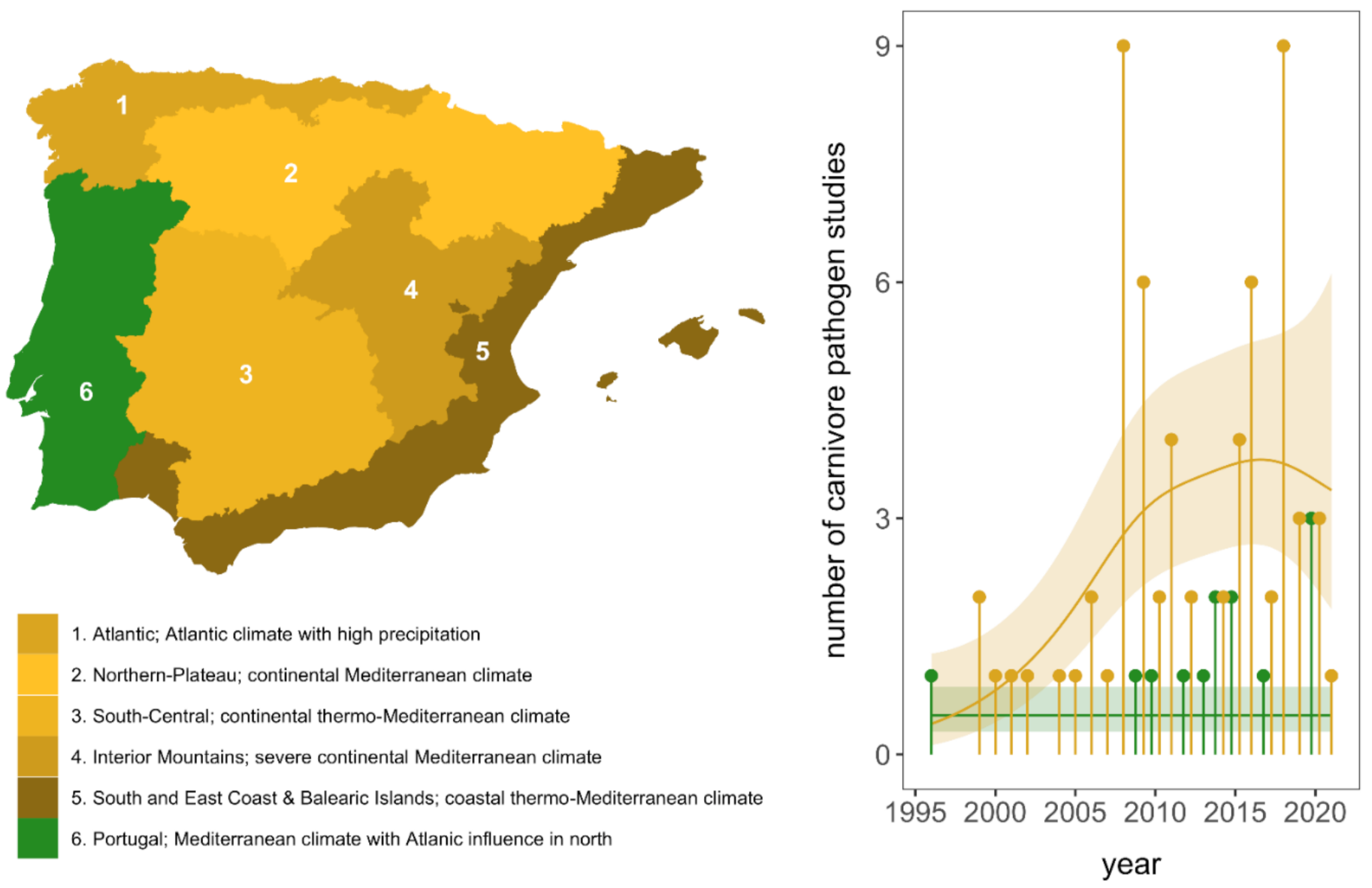
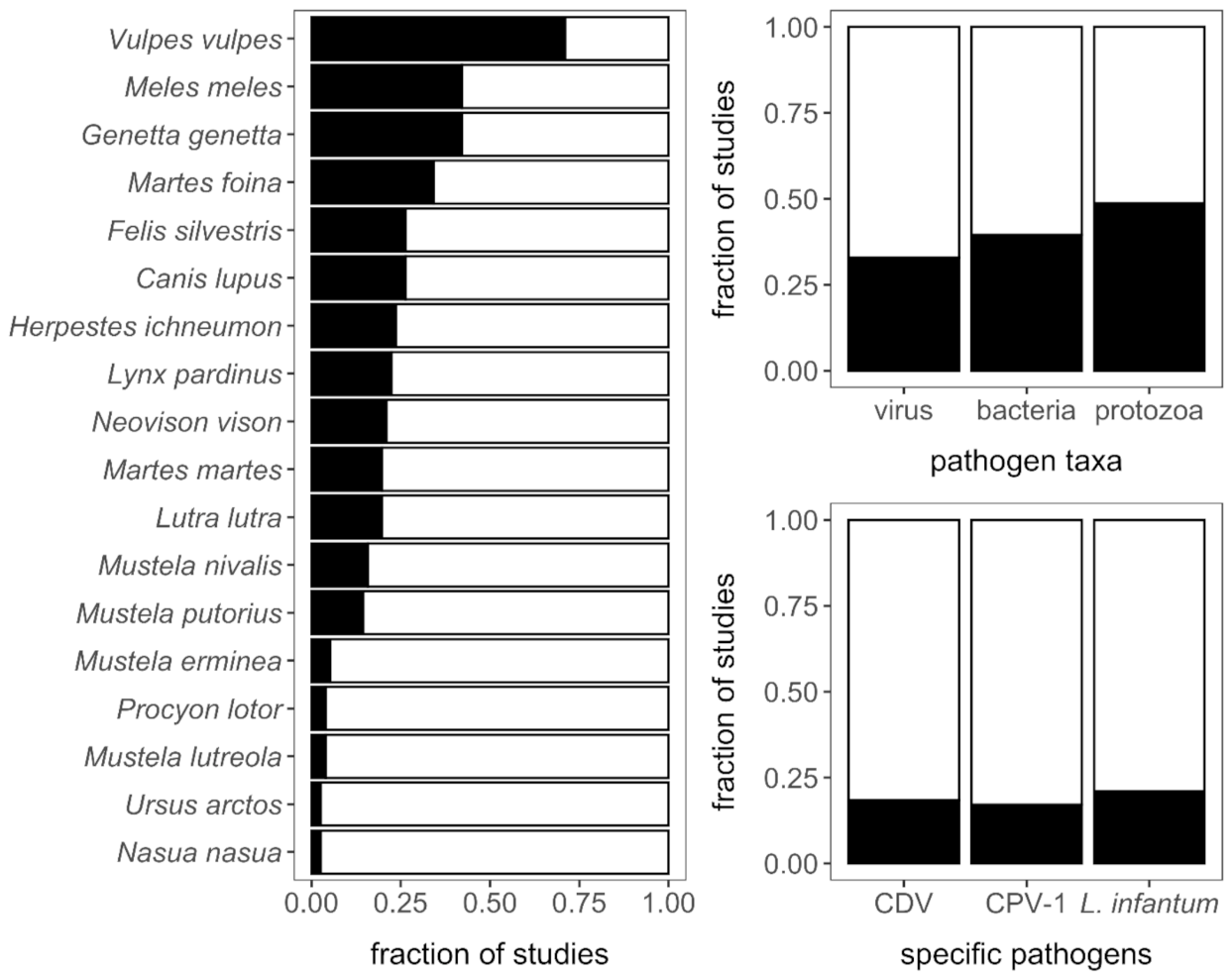
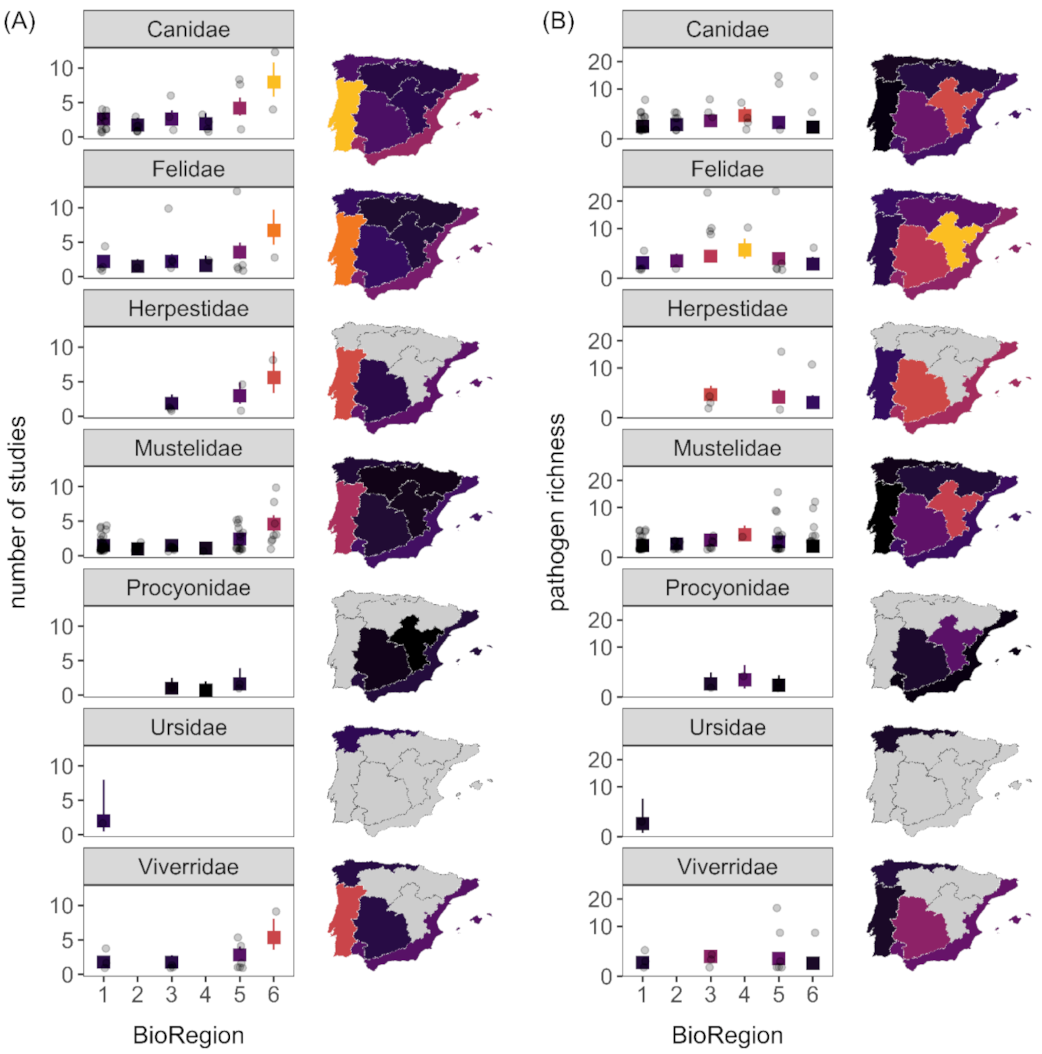
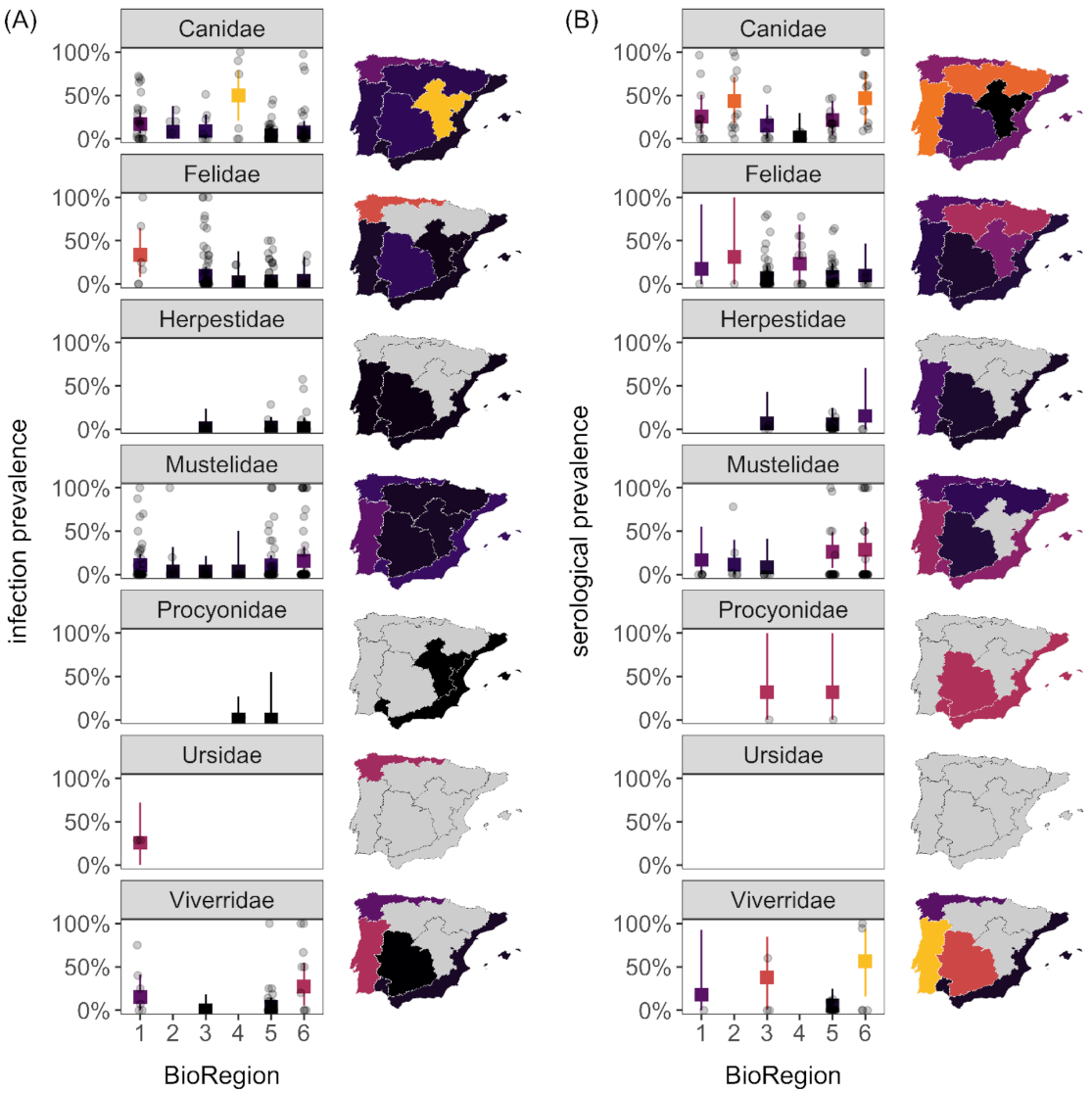
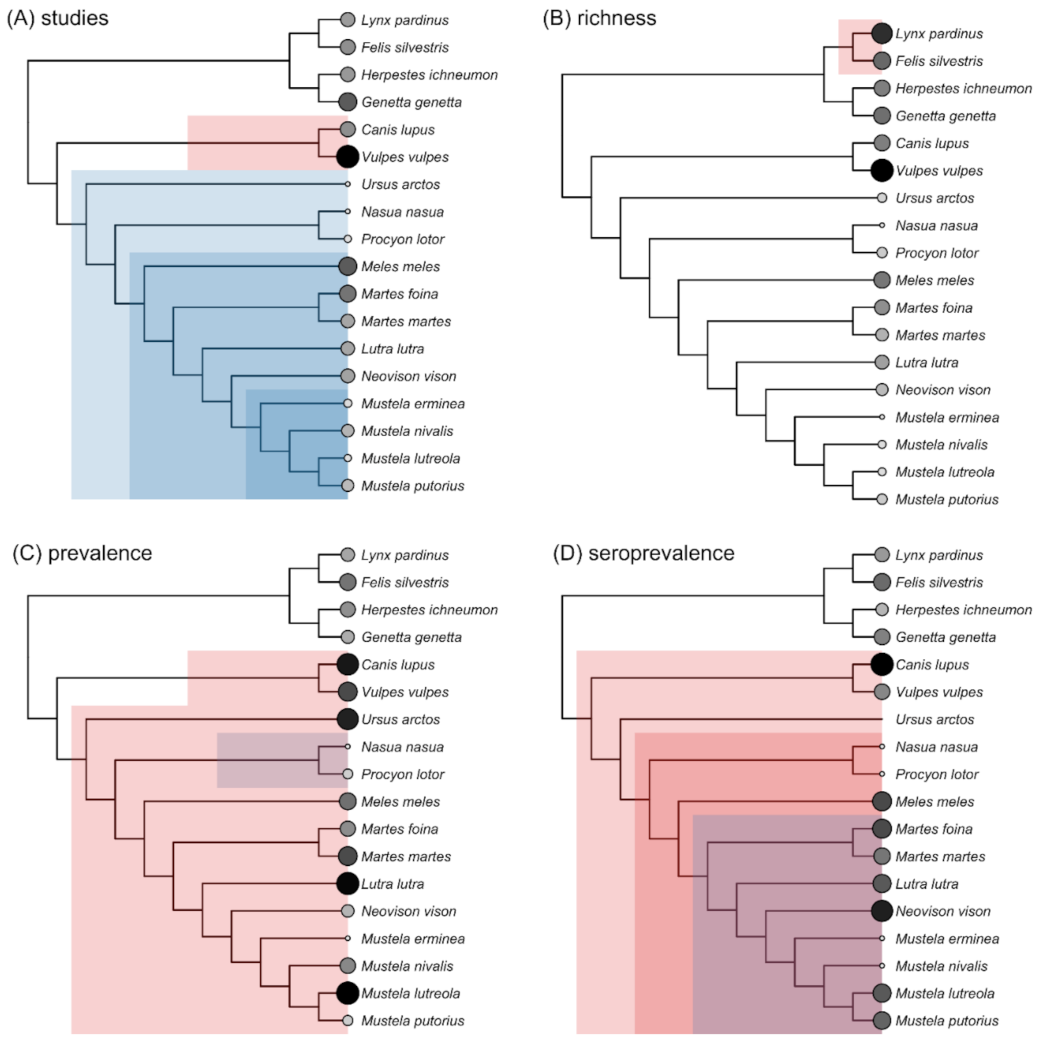

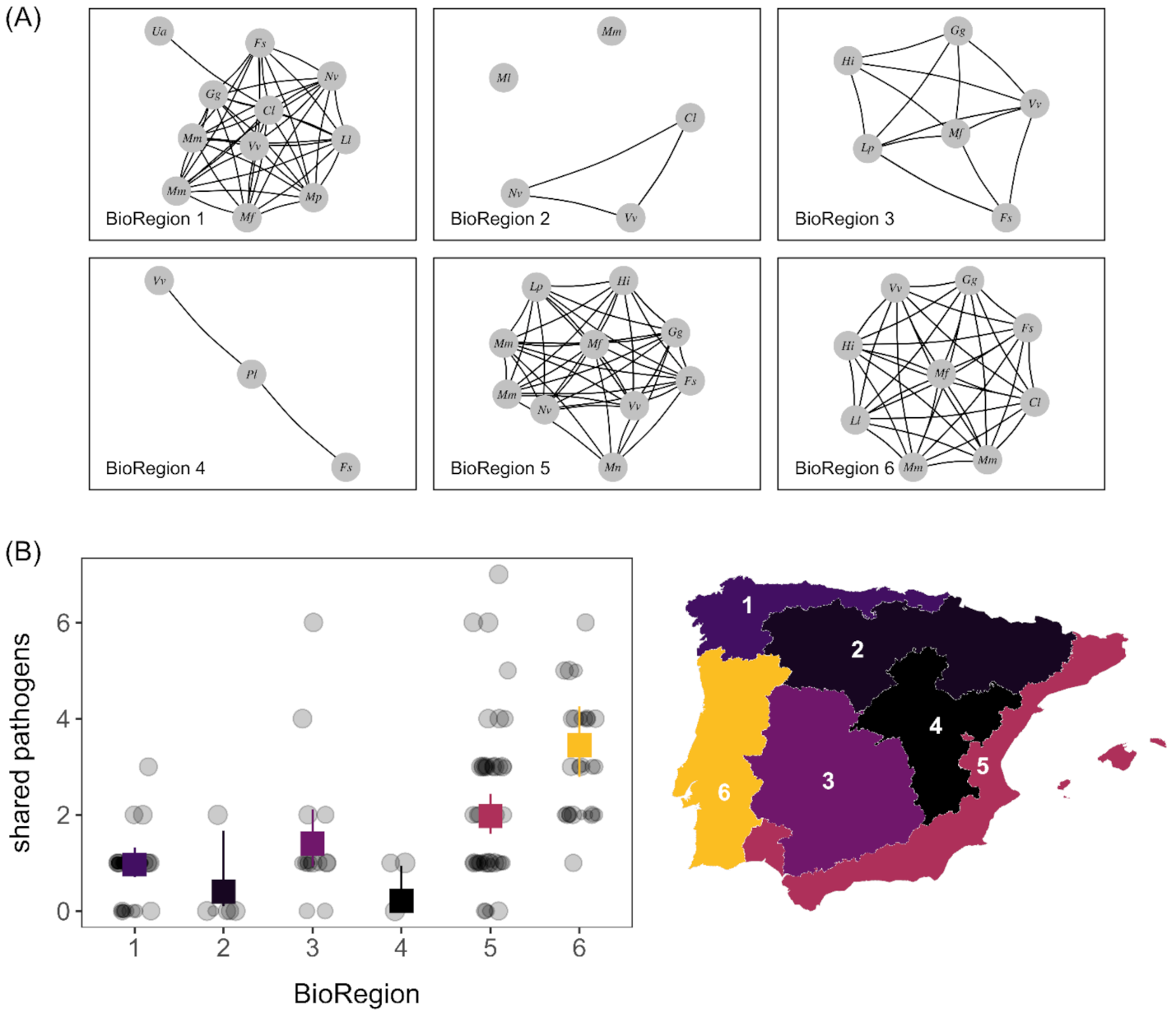
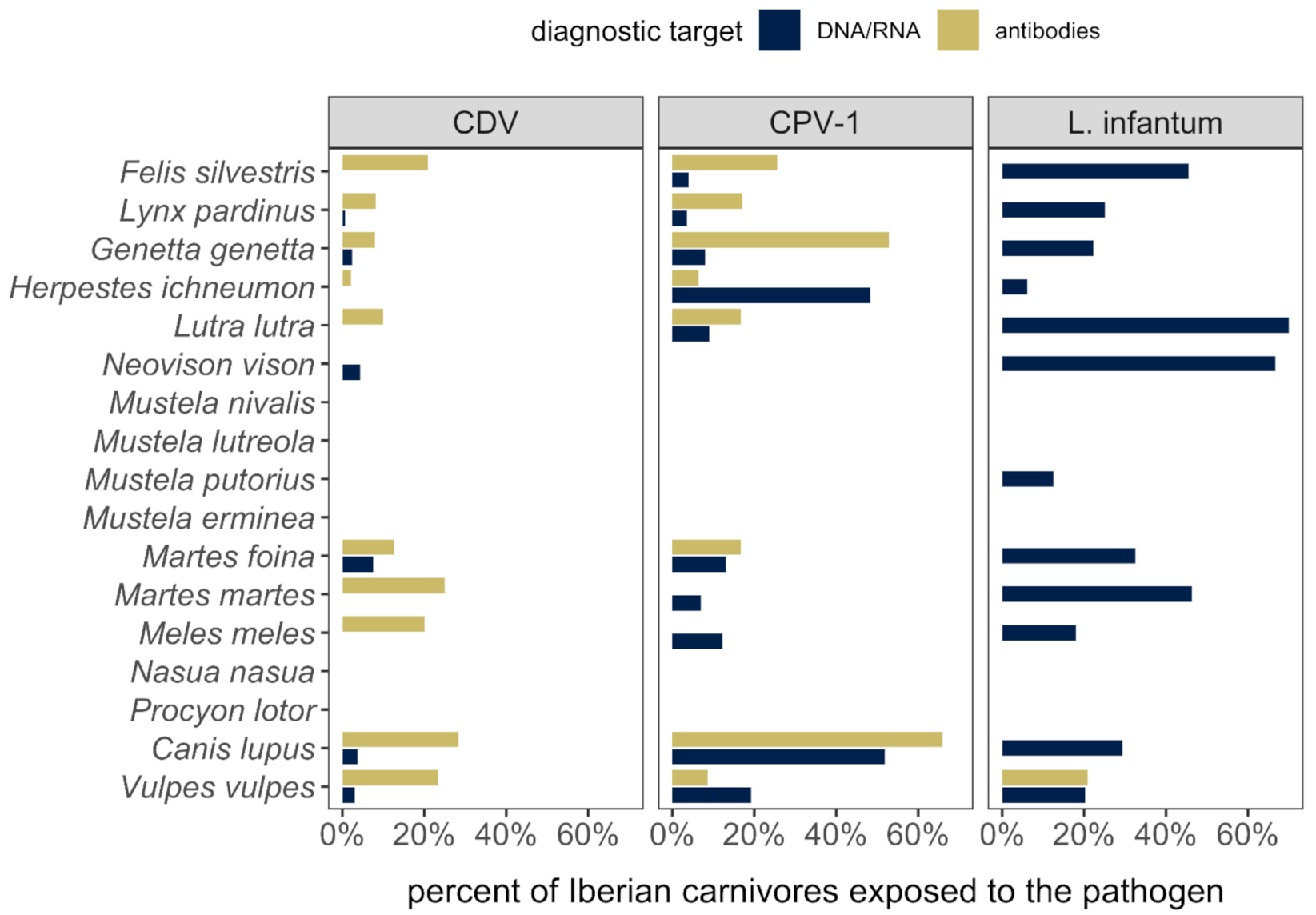
| Family/Species | Origin | Bioregions | Observations |
|---|---|---|---|
| Suborder Caniformia | |||
| Family Canidae | |||
| Wolf (Canis lupus) | Endemic | All | About 2000 individuals. Not evenly distributed (mostly in 1, 2, 6) |
| Fox (Vulpes vulpes) | Endemic | All | Legally hunted in Spain and Portugal |
| Family Mustelidae | |||
| Eurasian badger (Meles meles) | Endemic | All | |
| Pine marten (Martes martes) | Endemic | 1, 2, 5, 6 | Present in some of the Balearic Islands |
| Stone marten (Martes foina) | Endemic | All | Present in some of the Balearic Islands |
| Stoat (Mustela erminea) | Endemic | 1, 2, 5 | Only in the northernmost part of Iberia |
| European mink (Mustela lutreola) | Endemic | 1, 2 | Less than 500 indivuals |
| Western polecat (Mustela putorius) | Endemic | All | |
| Least weasel (Mustela nivalis) | Endemic | All | Present in some of the Balearic Islands |
| American mink (Neovison vison) | Introduced (recent) | 1, 2, 4, 5 | |
| Eurasian otter (Lutra lutra) | Endemic | All | |
| Family Ursidae | |||
| Brown bear (Ursus arctos) | Endemic | 1, 2 | About 250 individuals in (1) and 50 in (2) |
| Family Procyonidae | |||
| Raccoon (Procyon lotor) | Introduced (recent) | 4 | Occasional detections all around the peninsula and Mallorca Island. |
| South American coati (Nasua nasua) | Introduced (recent) | 6 | Recently introduced in Mallorca Island |
| Suborder Feliformia | |||
| Family Viverridae | |||
| Common genet (Genetta genetta) | Introduced (historical) | All | Present in some of the Balearic Islands |
| Family Herpestidae | |||
| Egyptian mongoose (Herpestes ichneumon) | Introduced (historical) | 3, 5, 6 | Legally hunted in Portugal |
| Family Felidae | |||
| European wildcat (Felis silvestris silvestris) | Endemic | All | |
| Iberian lynx (Lynx pardinus) | Endemic | 3, 5, 6 | About 1000 individuals, 60% in (3). |
Publisher’s Note: MDPI stays neutral with regard to jurisdictional claims in published maps and institutional affiliations. |
© 2021 by the authors. Licensee MDPI, Basel, Switzerland. This article is an open access article distributed under the terms and conditions of the Creative Commons Attribution (CC BY) license (https://creativecommons.org/licenses/by/4.0/).
Share and Cite
Millán, J.; Becker, D.J. Patterns of Exposure and Infection with Microparasites in Iberian Wild Carnivores: A Review and Meta-Analysis. Animals 2021, 11, 2708. https://doi.org/10.3390/ani11092708
Millán J, Becker DJ. Patterns of Exposure and Infection with Microparasites in Iberian Wild Carnivores: A Review and Meta-Analysis. Animals. 2021; 11(9):2708. https://doi.org/10.3390/ani11092708
Chicago/Turabian StyleMillán, Javier, and Daniel J. Becker. 2021. "Patterns of Exposure and Infection with Microparasites in Iberian Wild Carnivores: A Review and Meta-Analysis" Animals 11, no. 9: 2708. https://doi.org/10.3390/ani11092708
APA StyleMillán, J., & Becker, D. J. (2021). Patterns of Exposure and Infection with Microparasites in Iberian Wild Carnivores: A Review and Meta-Analysis. Animals, 11(9), 2708. https://doi.org/10.3390/ani11092708







